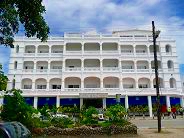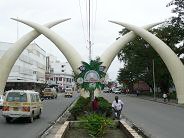www.kenya.eu
- HOME
- FACTS
- REGIONS & PLACES
- SAFARI
- SWAHILI LANGUAGE
- NEWS & ENTERTAINMENT
- BUSINESS
- TOOLS & CONTACTS
- FAQ & HELP
- ABOUT US
Mombasa port to the Indian Ocean
Mombasa is the great city down Kenya's Indian Ocean coast. With its old history it has not yet lost its fascinating old flair. The huge metal made tuskers on Moi Avenue in the center might be the city's landmark. In the last years since Mwai Kibaki took over presidency from the country's second president Mr. Daniel Toroitich Arap Moi one was able to realize various changes in the heart of the town.
The Tuskers have been painted again, the small retailers near the road who have been already used to that prosperous place of their daily income were sent away to clean up the image of the representative center. Castle HotelRoads have been maintained again and everything looks a bit cleaner nowadays. The municipality of Mombasa also tried to improve Moi Avenue planting some flowers and bushes in the middle of the road. Even the old and due to its colonial history famous Castle Hotel after serval years of neglected maintaining nowadays has been brought back to new brightness and beauty.

Mombasa is a very busy city. Around every corner one can find different shops and people doing small businesses like selling safaris, dvds, watches, sweets, cigarettes or the popular Miraa which in our regions might be better known as Khat. People like chewing Miraa because it is stimulating and creating euphoria. Especially the Askaris - the watchmen - who have to stay awake during their night shift often use that drug to fight sleep. Miraa or Khat due to its psychologically effective substances is controlled in many countries.
Mombasa's roads are full of cars, Matatus - private mini buses serving as a mean of public transport, TukTuks - three wheel motor rikshaws and of courses crowds of pedestrians. This city is also a loud and hectic place - surely not for relaxing in the sun but more for learning about the real life of the Kenyans and about the old history of trade relations with the Arabs creating the marvellous culture of the Swahili, the later landing of the Protuguese and naturally about the time of colonization and later independence from the British Crown.

Mombasa is a melting pot of cultures and nations. Walking through the roads you will find all tribes of the nation, from the coastal Mijikenda people, to the Luo, Kalenjin and Kikuyu from Central and North-Eastern Kenya up to the proud Masai still wearing their traditional clothes in the middle of this modern society. Church in MombasaIn Kenya's second largest city you can also easily realize the religious mixture. There are churches of the Christian religion brought by the Europeans exploring and colonizating the country in the 19th century and there are mosques representing the Islam that came with the Arabs over the Indian Ocean long time before Christianity. Sometimes one even is able to see some Buddhists or Hinduists praising Krishna with songs and music. Usually always not far the people who know where to look for will find a traditional Mijikenda healer - the Mganga who uses traditional herbs and sometimes magic spells to help the people with their daily needs and problems.
- Nairobi City
- Mombasa City
- Malindi City
- North Coast & Mtwapa Area
- South Coast & Ukunda Area
- Mount Kenya & Central Province
- Kisumu & Lake Victoria
- Kericho & Great Rift Valley
- Lake Nakuru